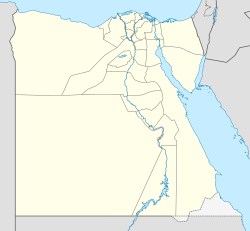Al-Hitan
| Vádí Al-Hitan | |
|---|---|
| Světové dědictví UNESCO | |
 kostra velryby | |
| Smluvní stát | |
| Souřadnice | 29°20′0″ s. š., 30°11′0″ v. d. |
| Typ | přírodní dědictví |
| Kritérium | viii |
| Odkaz | 1186 (anglicky) |
| Zařazení do seznamu | |
| Zařazení | 2005 (29. zasedání) |
Vádí Al-Hitan (arabsky وادي الحيتان, Wádí al-Ḥítán, v překladu Údolí velryb) je paleontologické naleziště v Egyptském guvernorátu Fajjúm, 150 km jihozápadně od Káhiry.[1]
V roce 2005 bylo přidáno na Seznam světového dědictví UNESCO, a to kvůli stovkám fosilií jednoho z nejstarších druhů velryb: archaeoceti (dnes již vyhynulé skupiny). Na světě není žádné jiné místo, na kterém by se nacházel takový počet a koncentrace těchto fosilií.[2]
Galerie
- Tvary v poušti
- (c) Roland Unger, CC BY-SA 3.0Jedna z koster
- Okolí naleziště
- Dorudon atrox
- Označení lokality
Odkazy
Reference
V tomto článku byl použit překlad textu z článku Wadi Al-Hitan na anglické Wikipedii.
- ↑ Archivovaná kopie. www.worldheritagesite.org [online]. [cit. 2014-04-21]. Dostupné v archivu pořízeném dne 2012-04-02.
- ↑ http://www.eoearth.org/view/article/156883/
Externí odkazy
 Obrázky, zvuky či videa k tématu Al-Hitan na Wikimedia Commons
Obrázky, zvuky či videa k tématu Al-Hitan na Wikimedia Commons
Média použitá na této stránce
Autor: Tom Horton from Shanghai, China, Licence: CC BY-SA 2.0
Wadi Al-Hitan is a very important fossil site that firmly establishes the fossil record of whale evolution from land mammals, one of Darwin's major assertions in The Origin of Species. The wadi hosts skeletons of families of archaic whales in their original geological and geographic setting of the shallow nutrient-rich bay of an early sea of some 30-40 million years ago, in what is now central Egypt.
There is no other place in the world yielding archaic whale fossils of such quality in such abundance and concentration -- over 400 cetacian skeletons have been discovered, the most important finds coming between 1985-1995. Many of the sirenians and cetaceans are preserved as virtually complete articulated skeletons which, uniquely, preserve reduced hind limbs, making them intermediate between earlier land mammals and later modern whales.
In addition to the whale fossils, numerous other fossils of plant and animal life provide a rich picture of the ecology of the Tethyan Ocean during Eocene time, enabling interpretation of how animals then lived and how they were related to each other. These fossils are the subject of continuing study and are of iconic value for the study of evolutionary transition, and make the site vitally important as a niche in Earth's natural history.Autor:
Wadi Al-Hitan (Whale Valley) (Egypt)
Autor: Tom Horton from Shanghai, China, Licence: CC BY-SA 2.0
Wadi Al-Hitan is a very important fossil site that firmly establishes the fossil record of whale evolution from land mammals, one of Darwin's major assertions in The Origin of Species. The wadi hosts skeletons of families of archaic whales in their original geological and geographic setting of the shallow nutrient-rich bay of an early sea of some 30-40 million years ago, in what is now central Egypt.
There is no other place in the world yielding archaic whale fossils of such quality in such abundance and concentration -- over 400 cetacean skeletons have been discovered, the most important finds coming between 1985-1995. Many of the sirenians and cetaceans are preserved as virtually complete articulated skeletons which, uniquely, preserve reduced hind limbs, making them intermediate between earlier land mammals and later modern whales.
In addition to the whale fossils, numerous other fossils of plant and animal life provide a rich picture of the ecology of the Tethyan Ocean during Eocene time, enabling interpretation of how animals then lived and how they were related to each other. These fossils are the subject of continuing study and are of iconic value for the study of evolutionary transition, and make the site vitally important as a niche in Earth's natural history.(c) Roland Unger, CC BY-SA 3.0
Sceleton, Whale Valley (Wadi el-Hitan), Libyan desert, Egypt













